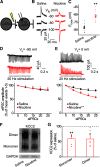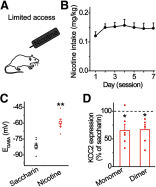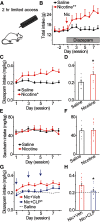Acute Nicotine Exposure Alters Ventral Tegmental Area Inhibitory Transmission and Promotes Diazepam Consumption
- PMID: 32102779
- PMCID: PMC7082131
- DOI: 10.1523/ENEURO.0348-19.2020
Acute Nicotine Exposure Alters Ventral Tegmental Area Inhibitory Transmission and Promotes Diazepam Consumption
Abstract
Nicotine use increases the risk for subsequent abuse of other addictive drugs, but the biological basis underlying this risk remains largely unknown. Interactions between nicotine and other drugs of abuse may arise from nicotine-induced neural adaptations in the mesolimbic dopamine (DA) system, a common pathway for the reinforcing effects of many addictive substances. Previous work identified nicotine-induced neuroadaptations that alter inhibitory transmission in the ventral tegmental area (VTA). Here, we test whether nicotine-induced dysregulation of GABAergic signaling within the VTA increases the vulnerability for benzodiazepine abuse that has been reported in smokers. We demonstrate in rats that nicotine exposure dysregulates diazepam-induced inhibition of VTA GABA neurons and increases diazepam consumption. In VTA GABA neurons, nicotine impaired KCC2-mediated chloride extrusion, depolarized the GABAA reversal potential, and shifted the pharmacological effect of diazepam on GABA neurons from inhibition toward excitation. In parallel, nicotine-related alterations in GABA signaling observed ex vivo were associated with enhanced diazepam-induced inhibition of lateral VTA DA neurons in vivo Targeting KCC2 with the agonist CLP290 normalized diazepam-induced effects on VTA GABA transmission and reduced diazepam consumption following nicotine administration to the control level. Together, our results provide insights into midbrain circuit alterations resulting from nicotine exposure that contribute to the abuse of other drugs, such as benzodiazepines.
Keywords: GABA; KCC2; benzodiazepines; chloride; dopamine; mesolimbic.
Copyright © 2020 Ostroumov et al.
Figures







Similar articles
-
Adolescent Nicotine Exposure Alters GABAA Receptor Signaling in the Ventral Tegmental Area and Increases Adult Ethanol Self-Administration.Cell Rep. 2018 Apr 3;23(1):68-77. doi: 10.1016/j.celrep.2018.03.030. Cell Rep. 2018. PMID: 29617674 Free PMC article.
-
Persistent Adaptations in Afferents to Ventral Tegmental Dopamine Neurons after Opiate Withdrawal.J Neurosci. 2015 Jul 15;35(28):10290-303. doi: 10.1523/JNEUROSCI.0715-15.2015. J Neurosci. 2015. PMID: 26180204 Free PMC article.
-
Disinhibition of Mesolimbic Dopamine Circuit by the Lateral Hypothalamus Regulates Pain Sensation.J Neurosci. 2023 Jun 14;43(24):4525-4540. doi: 10.1523/JNEUROSCI.2298-22.2023. Epub 2023 May 15. J Neurosci. 2023. PMID: 37188517 Free PMC article.
-
Tribute to: Self-administered nicotine activates the mesolimbic dopamine system through the ventral tegmental area [William Corrigall, Kathleen Coen and Laurel Adamson, Brain Res. 653 (1994) 278-284].Brain Res. 2016 Aug 15;1645:61-4. doi: 10.1016/j.brainres.2015.12.064. Epub 2016 Feb 8. Brain Res. 2016. PMID: 26867702 Review.
-
VTA GABA Neurons at the Interface of Stress and Reward.Front Neural Circuits. 2019 Dec 5;13:78. doi: 10.3389/fncir.2019.00078. eCollection 2019. Front Neural Circuits. 2019. PMID: 31866835 Free PMC article. Review.
Cited by
-
The serotonin 2A receptor agonist TCB-2 attenuates heavy alcohol drinking and alcohol-induced midbrain inhibitory plasticity.Addict Biol. 2022 Mar;27(2):e13147. doi: 10.1111/adb.13147. Addict Biol. 2022. PMID: 35229942 Free PMC article.
-
A paradoxical switch: the implications of excitatory GABAergic signaling in neurological disorders.Front Psychiatry. 2024 Jan 10;14:1296527. doi: 10.3389/fpsyt.2023.1296527. eCollection 2023. Front Psychiatry. 2024. PMID: 38268565 Free PMC article. Review.
-
A real-world pharmacovigilance study of FDA adverse event reporting system events for diazepam.Front Pharmacol. 2024 Jan 24;15:1278442. doi: 10.3389/fphar.2024.1278442. eCollection 2024. Front Pharmacol. 2024. PMID: 38327980 Free PMC article.
-
Midbrain KCC2 downregulation: Implications for stress-related and substance use behaviors.Curr Opin Neurobiol. 2024 Oct;88:102901. doi: 10.1016/j.conb.2024.102901. Epub 2024 Aug 13. Curr Opin Neurobiol. 2024. PMID: 39142020 Review.
-
Ionic Plasticity: Common Mechanistic Underpinnings of Pathology in Spinal Cord Injury and the Brain.Cells. 2022 Sep 17;11(18):2910. doi: 10.3390/cells11182910. Cells. 2022. PMID: 36139484 Free PMC article. Review.
References
-
- Büchel C, Peters J, Banaschewski T, Bokde AL, Bromberg U, Conrod PJ, Flor H, Papadopoulos D, Garavan H, Gowland P, Heinz A, Walter H, Ittermann B, Mann K, Martinot JL, Paillère-Martinot ML, Nees F, Paus T, Pausova Z, Poustka L, Rietschel M, et al. (2017) Blunted ventral striatal responses to anticipated rewards foreshadow problematic drug use in novelty-seeking adolescents. Nat Commun 8:14140. - PMC - PubMed
MeSH terms
Substances
Grants and funding
LinkOut - more resources
Full Text Sources
